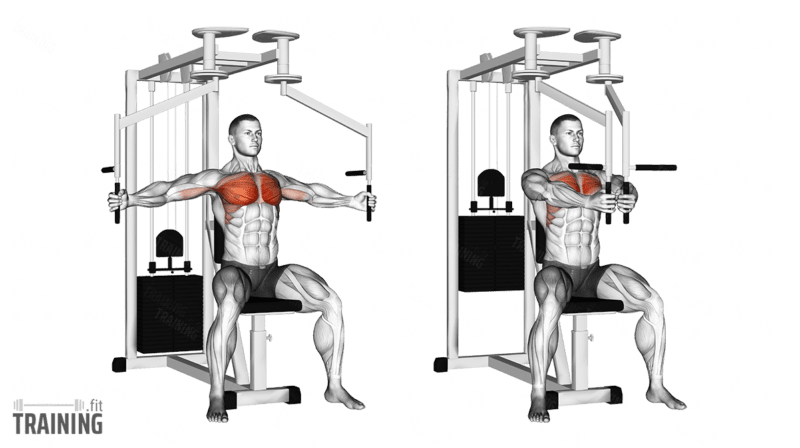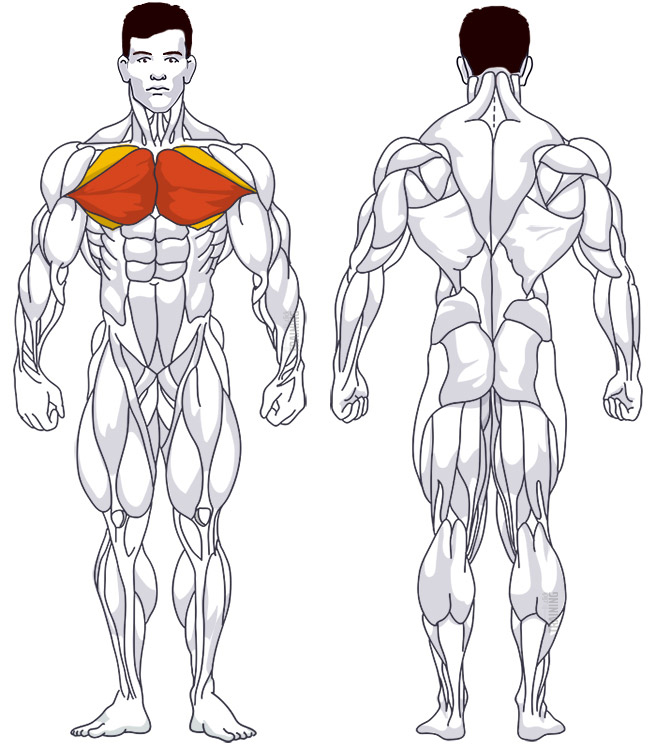Machine Fly
Isolation exercise, MachineOverview

Main muscles
- Chest: Large pectoral muscle
(Musculus pectoralis major)
Machine Fly: Basics and alternatives

Involved main muscle groups:
Machine Fly
The machine fly is a popular and widely used chest exercise. You sit upright and move the weight by bringing your extended arms together in front of your torso.
This exercise is a favorite because it’s easy to learn, and there’s a low chance of making mistakes. The machine fly works well as a supplement to the chest press, another machine-guided exercise. Both exercises target the mid-chest and complement each other nicely due to their different movements.
The machine fly can also be seen as a substitute for the dumbbell fly. In this exercise, you also bring the weight together in front of your body, but you do it while lying on your back and using dumbbells. That’s why the machine fly is sometimes called the “Pec Deck” fly.
As a semi-guided variation, you can try the cable chest fly. Similar exercises include the incline cable fly, where you lie on an inclined bench and your upper body isn’t upright. Two other alternatives are the dumbbell floor fly and the incline dumbbell fly.
For beginners, the machine fly is an excellent starting exercise. It allows you to isolate your pecs and prepare you for working with free weights (e.g., flyes, bench press, etc.).
Correct execution
There are different machine versions. Some have handles that keep your arms stretched, while others have bent elbows and forearm pads. Both variations have their advantages, but it’s ultimately up to your preference. Either way, you’ll target the same muscles. The machine with pads requires less stabilization and is somewhat better protected against incorrect execution due to deviation (see below).
In both variations, your chest muscles stretch, giving you a good muscle feeling during the exercise, especially in the starting position.
Video tutorial
Step-by-step instructions
Sit down on the seat and adjust the height so the handles or forearm pads are level with your chest. This ensures optimal force transfer to the machine through your chest. Start with a low weight to get a feel for the movement first.
Grab the handles with your hands. Your arms should be spread to the sides of your body. Press your upper back into the back pads of the machine and push your chest out.
Bring the handles together in front of your body. The effort should come only from your chest, not your arms. Keep your arms extended throughout the movement – the elbows should be slightly bent, not fully extended.
Push the handles together as far as the machine allows. The last part of the movement requires significant force, perfect for your chest workout.
Control the return of your arms to the starting position, maintaining tension in your chest at all times.
Common mistakes
Avoid using your triceps to move the weight. This can happen, especially with handle machines, as the load can be more easily supported by the arms. Instead, the movement should come from the chest. So focus on your pecs while you work out.
Also, be careful not to use your upper body to gain leverage. The execution should be – as always – controlled and without momentum. The effort to move the weight comes exclusively from your pectoral muscles. If that’s not possible, reduce the weight. Your chest muscles will benefit more from using a lower weight that allows for proper execution.